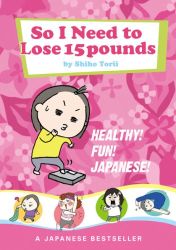So I Need To Review a Manga

American readers are, by now, familiar with manga and, naturally, familiar with the personal essay. But a combination of the two is something unusual and unfamiliar. New York and Japan based One Peace Books hopes to change that situation by introducing American readers to the popular contemporary Japanese “manga format essay” with Shiho Torii’s book So I Need to Lose 15 Pounds. The “manga essay” format that’s gaining popularity in Japan isn’t strictly educational manga like Shotaro Ishinomori’s Japan, Inc.: Introduction to Japanese Economics that first saw release in America in 1988. Nor is it exactly like the conventional narrative manga that American readers are most used to. The difference, however, is subtle.
Author and artist Shiho Torii’s manga is an anecdotal account of her five month long effort to lose 15 pounds. The report is fully illustrated in manga style, including an introductory ten pages published in color. Unlike conventional manga that convey information exclusively through dialogue and visuals, this manga essay incorporates a running commentary integrated into the art. The result feels not exactly like an informal essay nor a narrative manga, but a hybrid of both. The informal tone, the author’s good natured honesty, and the manga’s visual aesthetic make the inclusion of running commentary feel completely natural and, in fact, readers that aren’t looking for the subtle differences between a manga format essay and traditional manga may not consciously notice the difference.
One Peace Books’ edition of Torii’s manga is clearly aimed at mainstream American readers, but that shouldn’t alienate veteran manga fans at all. Torii’s drawing style is simple and accessible, but surprisingly expressive. The book is completely free of koukaon (visual sound effects). I don’t know if they’ve been edited out for the American publication or if Torii doesn’t employ them, but the art works just fine without them. The consistent use of small panels and the frequent use of screen toned background highlights keeps the art vibrant and active, in effect, substituting for conventional koukaon. There’s also no translation notes nor footnotes explaining Japanese visual puns like an oni horn on a domineering book editor’s head, but the art really doesn’t need minute explanations because its visual puns are few and infrequent, and they’re never intrusive nor confusing. Although never disguising the book’s cultural origin and setting, the English translation avoids Romanized words while still feeling very respectful. The English text feels completely natural, and it really does an excellent job of expressing the author’s personality.
So I Need to Lose 15 Pounds is author Shiho Torii’s account of being approached by an editor with a plan to chronicle a five month long attempt to lose 15 pounds. During her endeavour, Torii tried 27 different weight loss activities including swimming, walking, aerobics, macrobiotic dieting, glycemic index dieting, the BOOCS diet, spa treatments, colon cleansing, and even hypnosis. Torii structures her narrative chronologically and by diet, chronicling her gradual weight and body mass loss along the way. Doubtlessly many readers will be able to empathize with Torii’s efforts, as she honestly reveals herself as a person like many of us – concerned about her weight, but unmotivated to make drastic lifestyle changes and addicted to a comfortable but not entirely healthy lifestyle. The author’s experiences are fun to read. And it doesn’t take long for the reader to become familiar with Torii, her live-in sister, and her editor (and de facto diet manager). Readers share the lighthearted thrill of her advances and the disappointments of her dieting plateaus and small weight gains.
The book details, in a casual and friendly manner, advice and details on each weight loss technique Torii tried. In a brief index, Torii summarizes and each diet and assigns each diet a subjective ranking for effectiveness and accessibility. The book isn’t a formal guide to weight loss, nor does it aspire to be one. It’s a humorous reflection on one author’s personal fitness experiment. Some of the dieting efforts Torii attempted are unhealthy and possibly even dangerous. The book also reveals some distinctive Japanese perceptions and superstitions including fear that wearing a wet bikini causes colds, and wearing a tight bra causes internal organs to sag. Readers looking for safe and formal advice on weight loss should look to a conventional guide book. Readers interested in something entertaining can look here. For dieters, the book is a sympathetic companion. For mainstream readers it’s an accessible and fun introduction to a form of illustrated narrative that’s common in Japan but not very familiar in America. For manga fans, the book provides an interesting introduction to a different type of manga. The book’s larger dimensions, excellent print quality, and satisfying heft and paper quality certainly feel worth its $12.95 cover price.
Both the manga format essay and manga aimed at average, mainstream readers are unfamiliar concepts here in America, which may cause consumers to eye So I Need to Lose 15 Pounds with suspicion or dismiss it without greater examination. That would be unfortunate as this book, and this type of book, deserve some appreciation and circulation in America. Dieters and readers interested in an unconventional approach to weight loss literature will certainly enjoy reading this manga. Readers who aren’t motivated by dieting but are interested in the unique diversity of Japanese manga, or just want an enjoyable, unconventional read should also seriously consider giving So I Need to Lose 15 Pounds a shot.




